With the increasing acceptance of electric vehicles and the improving charging infrastructure, it is obvious that the big spike in adoption of BEVs is only waiting for the arrival of mass-market EVs. The true democratisation of electric mobility is just a few years away and the new ‘Tata Tiago.ev’ attempts to provide a taste of what is to come. What we all need could be a B-segment hatch that features a battery-electric powertrain and can be priced like a ICE hatch of today.
The Tata Tiago.ev has been officially unveiled a few weeks ago, and the company claims that it is already inundated with bookings. So, it is only the first 20,000 customers who will be offered the introductory prices ranging from ₹8.5 lakh to ₹10.7 lakh (ex-showroom). The Tiago.ev, like the Tigor.ev before it, has been built on a modified ICE platform, so certainly, Tata Motors enjoys a cost advantage. Forming a trio of offerings, the EV variants of the Nexon, Tigor and Tiago are positioned across size and price segments. However, the Tiago.ev breaks a psychological barrier with its promise of driving range, safety, and affordability. Does it live up to its hype? To find out, I headed to Goa last week to test drive the Tiago.ev in a mix of driving conditions — crowded, narrow roads of north Goa and the highway leading past the new airport at Mopa. Here are my first impressions.

The top-spec Tiago.ev that I was driving also sported other exterior features like a solid bonnet grille with ‘.ev’ logo in polycarbonate material
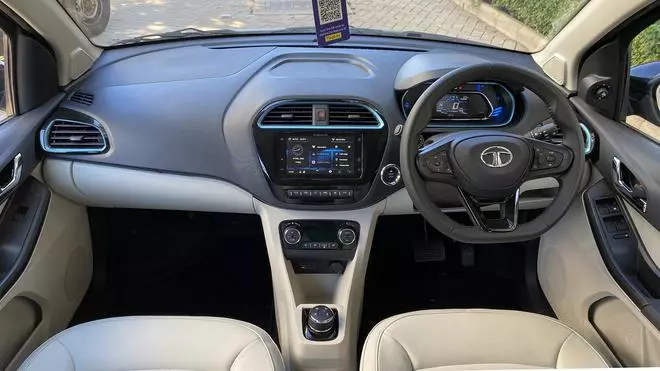
The instrument cluster is a digital unit and clearly displayed real-time data like the state of charge, driving mode, speedo, tripmeter, available range and other power unit info. | Photo Credit: BIJOY GHOSH
Design
The Tiago.ev’s design is unmistakably like that of the regular fossil fuel Tiago. Yes, it does get some individuality in the choice of colours and finishes, but the overall design is identical to the Tiago on our roads. That is still a good thing given that Tiago’s design hasn’t aged and it has always been appealing in both the hatch and sedan forms. The famous humanity line, which is a Tata trademark in the company’s design language till now, is finished in the EV signature metallic sky blue. My test mule was also finished in the teal blue body colour that Tata Motors has made the communication colour for all its EVs. The top-spec Tiago.ev that I was driving also sported other exterior features like a solid bonnet grille with ‘.ev’ logo in polycarbonate material, DRLs, fog lamps, a contrast black roof, projector headlamps, a reverse parking camera, aero-optimised alloys and low-rolling resistance tyres by Apollo. The rear of the Tiago.ev is also identical to the ICE version. The tail-lamps in the Tiago.ev are LEDs and the tailgate gets an electrical unlock. There is also a prominent logo in a new stylised font. The electric hatch is being offered in five body colours with the contrast roof option being available only in the top-trim variant of the larger battery version. The Tiago.ev can be had in five trim variants — two for the mid-range 19.2kWh battery pack and three variants for the long-range 24kWh pack.
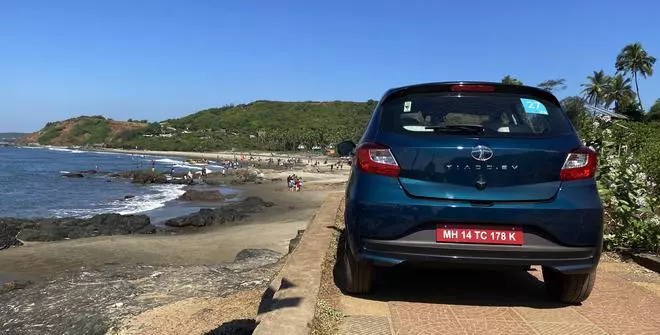
The tail-lamps in the Tiago.ev are LEDs and the tailgate gets an electrical unlock. | Photo Credit: BIJOY GHOSH
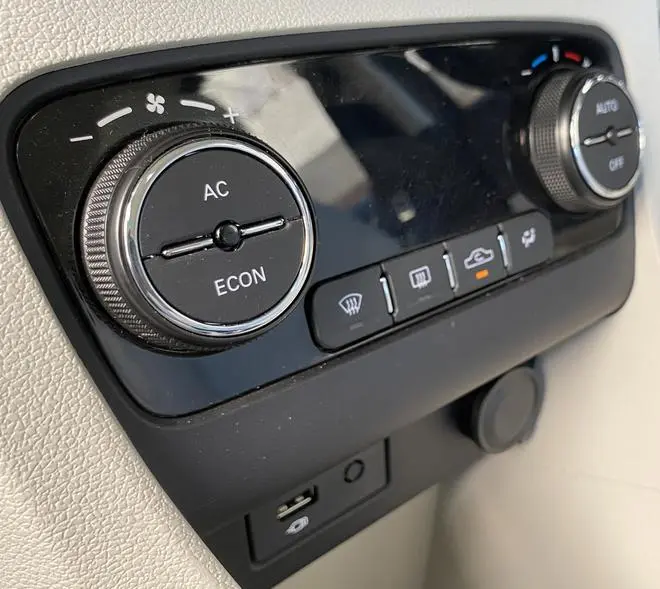
Features
The Tiago.ev’s cabin is also a familiar layout and design. It is good to see that there is no skimping on features because this is an electric. So, in terms of comparable kit, the EV is not a step down from the ICE variant. Of course, the features list will vary based on the trim variant chosen. My test mule featured leatherette seats, chrome inner door handles, electrically folding door mirrors, auto headlamps, rain-sensing wipers, auto-climate control and a leather-wrapped steering wheel. The other user-friendly features included cruise control, hill-start assist and hill-descent control. Cruise control is not really advisable if the driving conditions are going to vary since that can be a drain on the battery. My test mule also sported a cooled glovebox, but the other storage options were not really to my liking. A few of the centre console cubby-holes were a bit narrow and impractical, and the door pockets won’t be able to hold one-litre bottles. Plastics quality could have also been better. However, the touchscreen infotainment screen was large and offered Apple CarPlay and Android Auto connectivity. The instrument cluster was also a digital unit and clearly displayed real-time data like the state of charge, driving mode, speedo, tripmeter, available range and other power unit info. There is also a Harman-tuned music system with four speakers and four tweeters. The connectivity and remote operation suite of features can be enabled by using the ZConnect app. Space inside the cabin is identical to the ICE Tiago, which is then quite adequate.
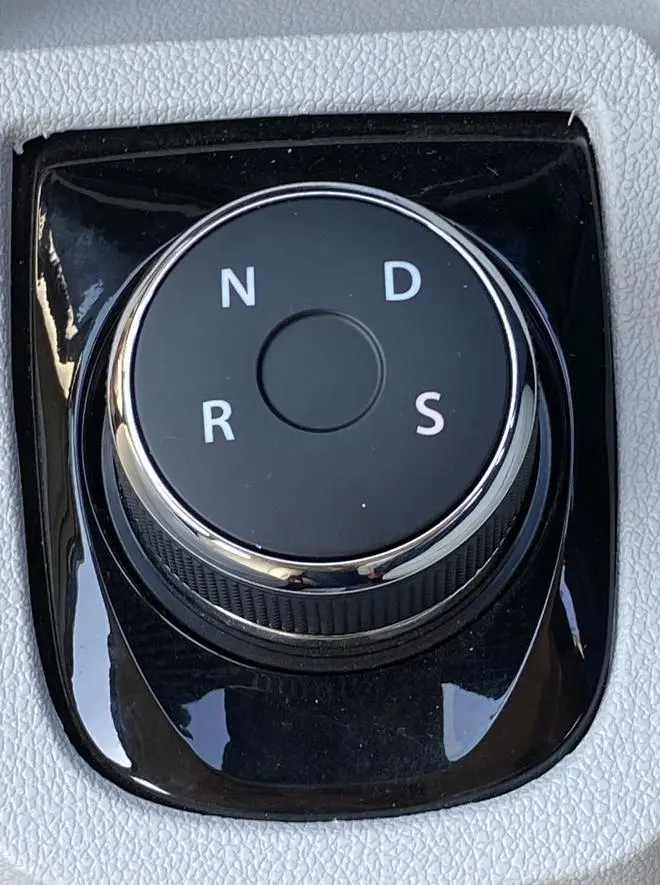
Performance
The battery pack in the new Tiago.ev is mounted under the floor and behind the rear passenger seat. Unlike the Nexon with its split battery units, the pack even in the long-range version (24kWh) of the Tiago.ev is a single unit. This does lead to a small restriction in the amount of space available in the boot. The fallout is the spare wheel can’t be mounted in the boot; instead, you will get a puncture repair kit. The battery pack in the long-range (LR) model is a 24kWh and the medium-range (LR) is a 19.2kWh pack. The lithium ferry phosphate cells in the battery pack are a safe and trusted chemistry, and Tata Motors has by now earned considerable testing and trust with its batteries.
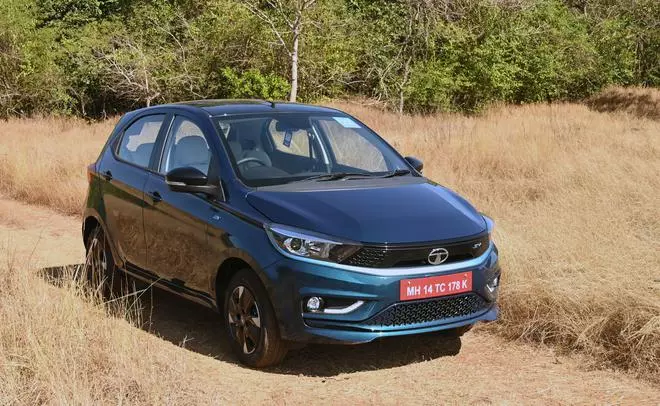
There are also four different regenerative braking modes to choose from, starting from zero regen (coasting) and three regen braking modes with Level 3 being the highest | Photo Credit: BIJOY GHOSH
The LR pack can be charged from about 10 per cent to full charge in less than nine hours via a wall socket. The 7.2kW AC wall-box charger that the top trim variant gets can deliver the same charge in about three-and-half hours. And a DC fast charger can juice up 80 per cent of the battery in less than an hour. The LR battery can deliver a ARAI-rated driving range of 315km and the MR can deliver a rated range of 257kms. Of course, real-world driving range will vary depending on driving style and road and traffic conditions. My test mule at the end of a 6-hour drive and shoot schedule displayed a range of about 190km (effective), though that included nearly an hour of parking with the aircon on.
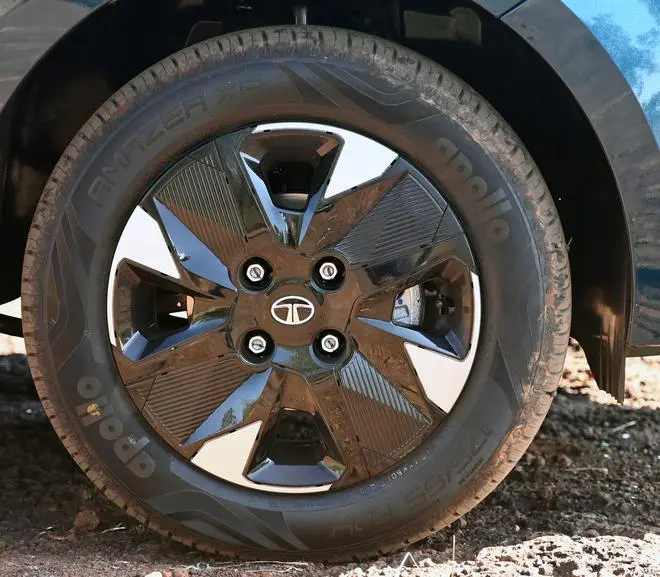
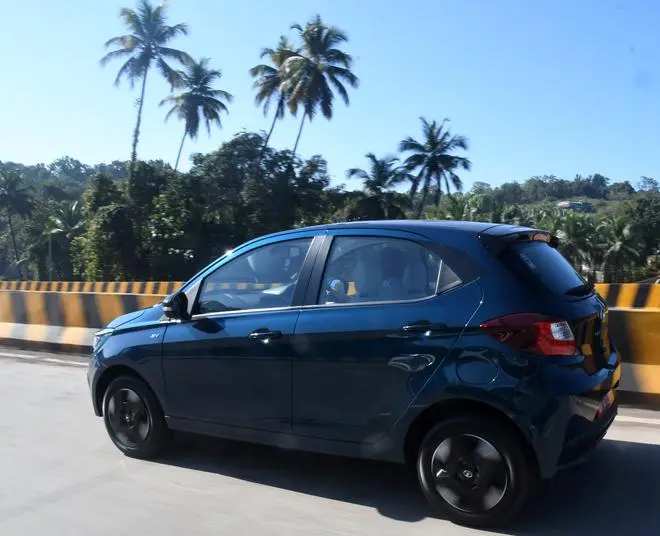
The LR variants gets a slightly higher rated electric motor that generates a peak power of about 74hp and peak torque of 114Nm. The MR variants get a motor that delivers about 60hp and 110Nm. As electrics become more prevalent, more and more customers are only interested in torque as a metric, quite understandably, given how instant peak torque availability at the wheel is the more useful measure. In that department, despite the numbers seeming average, the Tiago.ev does feel very peppy. Driving my test mule on some private roads in the outskirts of Goa reveals how agile the new Tata EV is and how quickly it can cross over into 3-digit speeds. There is a certain sense of light-footed performance that comes through. The Tiago.ev actually feels a bit high-sprung, probably from the slightly raised suspension setting and the relatively small 14-inch rims. However, the suspension is quite accommodating without feeling over pliant. Some of the kutcha roads and broken sections of the old highway were dismissed with ease and there is a sense of robustness about the suspension behaviour even at higher speeds. Some minor adjustments to the suspension settings have been made in the Tiago.ev to handle the minor variation in weight distribution compared to the ICE Tiago.
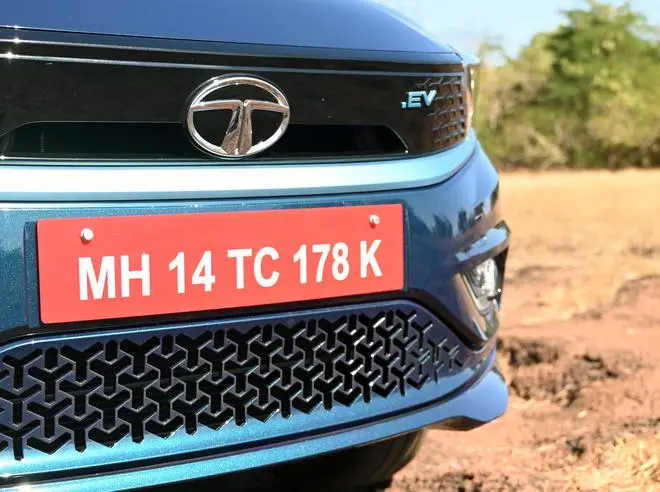
There are two drive modes to choose from including City and Sports. There are also four different regenerative braking modes to choose from, starting from zero regen (coasting) and three regen braking modes with Level 3 being the highest. One-pedal driving with Level regen is possible with some practice. The regen levels can be chosen using a couple of buttons on the centre stack for increasing or reducing the regen levels. So effectively, the Tiago.ev gets eight different driving modes.
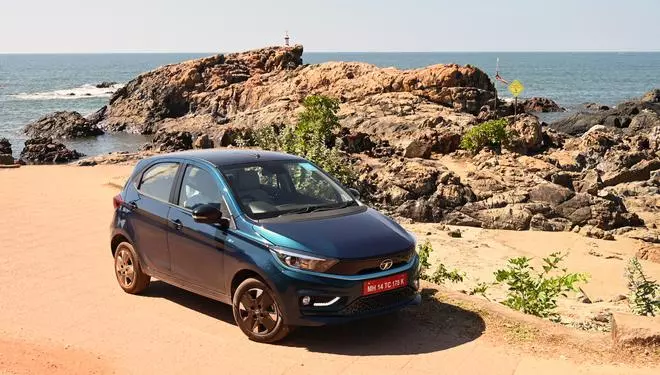
The Tiago.ev, like the Tigor.ev before it, has been built on a modified ICE platform, so certainly, Tata Motors enjoys a cost advantage. | Photo Credit: BIJOY GHOSH
Bottom Line
The new Tiago.ev gets two airbags as standard. And the Tiago’s generic structural integrity and safety is already good. Also adequate protection has apparently been provided for the battery pack. The Tiago.ev Is an excellent package overall. With an accepted sense of reliability, safety and quality that has come to be about Tata’s vehicles, the Tiago.ev will be equally attractive for anyone looking to go electric. The booking numbers have a tale to tell with 23 per cent of customers being first-time EV buyers and almost 55 per cent of them being under the age of 40 years. Prices range from ₹8.5 lakh to ₹10.7 lakh (ex-showroom).




Comments
Comments have to be in English, and in full sentences. They cannot be abusive or personal. Please abide by our community guidelines for posting your comments.
We have migrated to a new commenting platform. If you are already a registered user of TheHindu Businessline and logged in, you may continue to engage with our articles. If you do not have an account please register and login to post comments. Users can access their older comments by logging into their accounts on Vuukle.